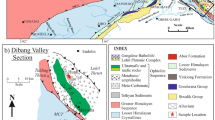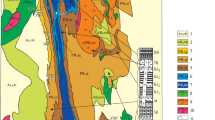Abstract
The Upper Jurassic Mozduran Formation with a thickness of 420 m at the type locality is the most important gas-bearing reservoir in NE Iran. It is mainly composed of limestone, dolostone with shale and gypsum interbeds that grade into coarser siliciclastics in the easternmost part of the basin. Eight stratigraphic sections were studied in detail in south of the Agh-Darband area. These analyses suggest that four carbonate facies associations and three siliciclastic lithofacies were deposited in shallow marine to shoreline environments, respectively. Cementation, compaction, dissolution, micritization, neomorphism, hematitization, dolomitization and fracturing are diagenetic processes that affected these sediments. Stable isotope variations of δ18O and δ13C in carbonate rocks show two different trends. High depletion of δ18O and low variation of δ13C probably reflect increasing temperatures during burial diagenesis, while the higher depletion in carbon isotope values with low variations in oxygen isotopes are related to fresh water flushing during meteoric diagenesis. Negative values of carbon isotopes may have also resulted from organic matter alteration during penetration of meteoric water. Fe and Mn enrichment with depletion of δ18O also supports the contention that alteration associated with higher depletion in carbon isotope values with low variations in oxygen isotopes took place during meteoric diagenesis. The presence of bright luminescence indicates redox conditions during precipitation of calcite cement.










Similar content being viewed by others
References
Adabi MH, Rao CP (1991) Petrographic and geochemical evidence for original aragonite mineralogy of Upper Jurassic carbonate (Mozduran Formation), Sarakhs Area, Iran. Sediment Geol 72:253–267
Adabi MH, Moussavi-Harami R, Mahboubi A, Shemirani A (2006) Petrography, elemental and isotope variation of rudist biostrome of Maastrichtian platform in east Kopet-Dagh basin, NE Iran. J Geol Soc Iran 1:1–10
Adachi N, Ezaki Y, Liu J (2004) The origins of peloids immediately after the end-Permian extinction, Guizhou Province, South China. Sediment Geol 164:161–178
Adams AE, Mackenzie WS (1998) A color atlas of carbonate sediments and rocks under the microscope. Manson Publishing, London, p 180
Aeshar-Harb A (1994) Geology of the Kopet-Dagh: Tehran, Geological Survey of Iran, 265 p
Afshar-Harb A (1979) The stratigraphy, tectonics and petroleum geology of the Kopet-Dagh Region, Northern Iran. PhD thesis, Imperial College of Sciences, University of London, UK, 316 p
Ahmad AHM, Bhat GM (2006) Petrofacies, provenance and diagenesis of the Dhosa Sandstone Member (Chari Formation) at Ler, Khachchh sub-basin, western India. Asian J Earth Sci XX:1–16
Alavi M, Vaziri H, Seyed-Emami K, Lasemi Y (1997) The Triassic and associated rocks of the Aghdarband areas in central and northeastern Iran as remnant of the southern Turanian active continental margin. Geol Soc Am Bull 109:1563–1575
Alsharhan AS, Kendall CGSTC (2003) Holocene coastal carbonates and evaporites of the southern Arabian Gulf and their ancient analogues. Earth Sci Rev 61:191–243
Amini Z, Rao CP (1998) Depth and latitudinal characteristic of sedimentological and geochemical variables in temperate shelf carbonates, eastern Tasmania, Australia. Carbonates Evaporites 13:142–156
Anderson TF, Arthur MA (1983) Stable isotopes of oxygen and carbon and their application to sedimentologic and paleoenvironmental problems. In: Arthur MA, Anderson TF, Kaplan IR, Veizer J, Land L (eds) Stable isotopes in sedimentary geology: SEPM Short Course Notes 10, Section 1.1, pp 1–151
Bathurst RGC (1975) Carbonate sediments and their diagenesis. Developments in sedimentology, 2nd edn, vol 12. Elsevier, Amsterdam, 658 p
Berberian M, King GCP (1981) Toward paleogeographic and tectonic evolution of Iran. Can J Earth Sci 18:210–265
Brand U, Veizer J (1980) Chemical diagenesis of the multi component carbonate system-1: trace elements. J Sediment Petrol 50:1219–1236
Budd DA (1997) Cenozoic dolomites of carbonate Island: their attributes and origin. J Earth Sci Rev 42:1–47
Burchette TP, Wright VP, Faulkner TJ (1990) Oolithic sand body depositional models and geometries, Mississippian of southwest Britain: implication in carbonate ramp settings. Sediment Geol 68:87–115
Carols LJ (2002) Diagenetic history of the Upper Jurassic Smackover Formation and its effects on reservoir properties: Vocation Field, Manila Sub-Basin, Eastern Gulf Coastal Plain. Gulf Coast Assoc Geol Soc Trans 52:631–644
Choquette PW, James NP (1987) Diagenesis in limestones-3. The deep burial environment. Geosci Can 14:3–35
Coffey BP, Read JF (2004) Mixed carbonate-siliciclastic sequence stratigraphy of paleogene transition zone continental shelf southeastern USA. Sediment Geol 166:21–57
Dickson JAD (1966) Carbonate identification and genesis as revealed by staining. J Sediment Petrol 36:441–505
Ehrenberg SN, Pickard NAH, Svana TA, Oxtoby NH (2002) Cement geochemistry of photozoan carbonate strata (Upper Carboniferous-Lower Permian), Finnmark carbonate platform, Brents Sea. J Sediment Res 72:95–115
Flugel F (2004) Microfacies of carbonate rocks—analysis, interpretation and application. Springer, Berlin, p 967
Fortuin AR, Krijgman W (2003) The Messinian of the Nijar basin (SE Spain): sedimentation, depositional environments and paleogeographic evolution. Sediment Geol 160:213–242
Fouke BW, Zerkle AL, Alvarez W, Pope KO, Ocampos AG, Wachtman RJ, Nishimura JMG, Claeys P, Fischer AG (2002) Cathodoluminescence petrography and isotope geochemistry of KT impact eject deposited 360 km from the Chicxulub Cracter, at Albion Island, Belize. Sediment Geol 49:117–138
Frank JR, Carpenter AB, Oglesby TW (1982) Cathodoluminescence and composition of calcite cement in the Taum Sauk Limestone (Upper Cambrian), South Missouri. Sediment Geol 52:631–638
Frank TC, Lohmann KC, Meyers WJ (1995) Chronostratigraphic significance of cathodoluminescence zoning is syntaxial cement: Mississippian Lake Vally Formation, New Mexico. Sediment Geol 105:29–50
Friedman I, O’Neil JR (1977) Compilation of stable isotope fractionation factors of geochemical interest. In: Fleischer M (ed) Data of geochemistry, 6th edn. US Geological Survey Prof. Paper, 440-KK, pp 1–12
Holz M (2003) Sequence stratigraphy of lagoonal estuarine system-an example from the Lower Permian Rio Benito Formation, Parana basin, Brazil. Sediment Geol 102:305–331
Hudson JD (1977) Stable isotopes and limestone lithification. J Geol Soc Lond 133:637–660
James NP, Choquette PW (1983) Diagenesis, 6, limestones-the sea floor diagenetic environment. Geosci Can 10:162–179
Kim Y, Lee YI (2004) Diagenesis of shallow marine sandstones, the Lower Ordovician Dongjeom Formation, Korea: response to relative sea-level changes. J Asian Earth Sci 23:235–245
Kyser TK, James NP, Bone I (2002) Shallow burial dolomitization of Cenozoic cool water limestone, southern Australia. Geochemistry and origin. J Sediment Res 72:146–157
Lohmann KC (1988) Geochemical patterns of meteoric diagenetic systems and their application to studies of paleokarst. In: James NP, Chaquette PW (eds) Paleokarst. Springer, New York, pp 58–80
Macaulay GI, Beckett DB, Braithwaite K, Bliefnick D, Phips BM (2001) Constraints on diagenesis and reservoir quality in the fractured Hasdrabal Field, offshore Tunisia. J Pet Geol 24:55–78
Machent PG, Taylor KG, Macquaker JH, Marshall JD (2007) Pattern of early post-depositional and burial cementation in distal shallow marine sandstones: Upper Cretaceous Keniworth Member, Book Cliffs, Utah, USA. Sediment Geol 198:125–145
Mahboubi A, Moussavi-Harami R, Yahya-Shaybani V, Najafi M, Gonzalez L (2004) Petrographic and geochemical evidence for paragenetic sequence interpretation of the Lower Cretaceous limestones in the eastern Binalood Mountain Range, NE Iran. Iran Int J Sci 5(2):181–201
Mahboubi A, Moussavi-Harami R, Aghaei A, Aletaha H (2006) Sequence stratigraphy and palaeogeography of the Upper Jurassic reservoir equivalent along the outcrop belt in the Agh-Darband area, northeastern Iran. The 6th international conference on the geology of the middle east, Al-Ain, UAE, 20–23 March 2006, p 104
Marshall DJ (1988) Cathodoluminescence of geological materials. Unwin Hyman, Boston, p 146
Marshall JD, Ashton M (1980) Isotopic and trace element evidence for submarine lithification of hardground in Jurassic of England. Sedimentology 27:271–289
Martin-Chivelet J, Ramirez Del Pozo J, Tronchetti G, Babinot JF (1995) Palaeoenvironmet and evolution of the upper Maastrichtian platform in the Betic continental margin, SE Spain. Palaeogeogr Palaeoclimatol Palaeoecol 119:169–186
Meyers WJ (1989) Trace element and isotope geochemistry of zoned calcite cements, Lake Valley Formation (Mississippian, New Mexico): insights from water–rock interaction modeling. Sediment Geol 65:355–370
Miall AD (1997) The geology of stratigraphic sequences. Springer, Berlin, p 433
Milliman JD (1974) Marine carbonates. Springer, New York, p 375
Milliman JD, Muller J (1977) Characteristics and genesis of shallow-water and deep-sea limestone. In: Anderson NR, Malahoff A (eds) The fate of fossil fuel CO2 in the oceans. Plenum Press, New York, pp 655–672
Morse JW, Mackenzie FT (1990) Geochemistry of sedimentary carbonates. Elsevier, New York
Moussavi-Harami R (1989) Depositional history of Upper Jurassic (Oxfordian–Kimmeridgian) carbonates and evaporites in northeastern Iran (abs.). In: Proceedings of the 28th international geological congress, Washington, DC, 2471 p
Moussavi-Harami R, Brenner RL (1992) Geohistory analysis and petroleum reservoir characteristics of Lower Cretaceous (Neocomian) sandstone, eastern portion of Kopet-Dagh basin, northeast Iran. Am Assoc Pet Geol Bull 76:1200–1208
Nelson CS, Smith AM (1996) Stable oxygen and carbon isotopes composition fields for skeletal and diagenetic components in New Zealand Cenozoic non-tropical carbonate sediments and limestones: a synthesis and review. NZ J Geol Geophys 39:93–107
Pingitore NE, Eastman MP, Sandidge M, Oden K, Freiha B (1988) The coprecipitation of manganese (II) with calcite, an experimental study. Mar Chem 25:107–120
Price GD, Sellwood BW (1994) Palaeotemperature indicated by Upper Jurassic (Kimmeridgian-Tithonian) fossils from Mallorca determined by oxygen isotope composition. Palaeogeogr Palaeoclimatol Palaeoecol 110:1–10
Rahimpour-Bonab H, Bone Y, Moussavi-Harami R (1997) Stable isotopes aspects of modern molluska, brachiopods and marine cements from cool-water carbonate, Lacepede Shelf, South Australia. Geochim Cosmochim Acta 61:207–218
Ruttner AW (1993) Southern borderland of Triassic Laurasia in northeast Iran. Geol Rundsch 82:110–120
Sanders D, Hofling R (2000) Carbonate deposition in mixed siliciclastic–carbonate environments on top of an orogenic wedge (Late Cretaceous, Northern Calcareous Alps, Austria). Sediment Geol 137:127–146
Schneider AJ, Wall HD, Bechstadt T (2004) Magnetic susceptibility variation in carbonates of the La Vid Group (Cantabrian Zone NW-Spain) related to burial diagenesis. Sediment Geol 166:73–88
Shackleton NJ, Kennett JP (1975) Palaeotemperature history of the Cenozoic and the initiation of Antarctic glaciation: oxygen and carbon isotope analysis in DSDP Sites 277–279 and 281. Initiate report DSDP XX1X, pp 743–755
Sibley DF, Greeg JM (1987) Classification of dolomite rock textures. J Sediment Petrol 57:967–975
Tamura T, Masuda F (2003) Shallow-marine fan delta slope deposits with large-scale cross-stratification: the Plio-Pleistocene Zaimokuzawa formation in the Ishikari Hills, northern Japan. Sediment Geol 158:195–207
Tucker ME (1988) Techniques in sedimentology. Blackwell, Oxford, 394p
Tucker ME (1993) Carbonate diagenesis and sequence stratigraphy. In: Wright VP (ed) Sedimentary review. Blackwell, Oxford, pp 208–226
Tucker ME, Wright VP (1990) Carbonate sedimentology. Blackwell, Oxford, 482p
Vail PR, Audemart F, Bowman SA, Einser PN, Perez Cruz G (1991) The stratigraphic significances of tectonics, eustasy and sedimentology an overview. In: Einsle G, Ricken W, Seilacher A (eds) Cycles and events in stratigraphy. Springer, Berlin, pp 617–659
Vincent B, Emmanuel L, Houel P, Loreau J (2007) Geodynamic control on carbonate diagenesis: petrographic and isotopic investigation of the Upper Jurassic Formations of the Paris Basin (France). Sediment Geol 197:267–289
Warren J (2006) Evaporites, sediments, resource and hydrocarbons. Springer, Berlin, p 1035
Weible R, Friis H (2004) Opaque minerals as keys for distinguishing oxidizing and reducing diagenetic conditions in the lower Triassic Bunter Sandstone, North German Basin. Sediment Geol 169:121–128
Winefield PR, Nelson CS, Hodder APW (1996) Discriminating temperate carbonates and their diagenetic environments using bulk elemental geochemistry: a reconnaissance study based on New Zealand Cenozoic limestones. Carbonates Evaporites 11:19–31
Yechieli Y, Wood WW (2003) Hydrogeologic processes in saline systems: playas, sabkhas, and saline lakes. Earth Sci Rev 58:343–365
Author information
Authors and Affiliations
Corresponding author
Rights and permissions
About this article
Cite this article
Mahboubi, A., Moussavi-Harami, R., Carpenter, S.J. et al. Petrographical and geochemical evidences for paragenetic sequence interpretation of diagenesis in mixed siliciclastic–carbonate sediments: Mozduran Formation (Upper Jurassic), south of Agh-Darband, NE Iran. Carbonates Evaporites 25, 231–246 (2010). https://doi.org/10.1007/s13146-010-0028-z
Accepted:
Published:
Issue Date:
DOI: https://doi.org/10.1007/s13146-010-0028-z




